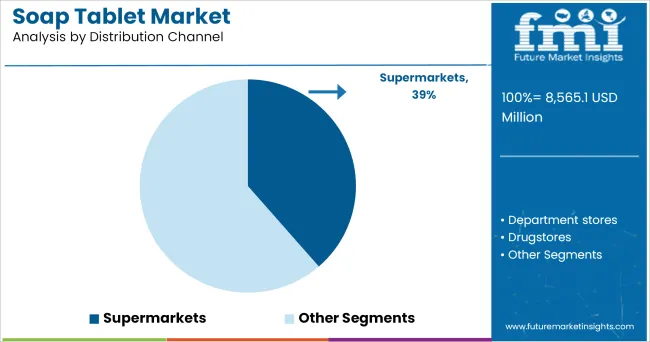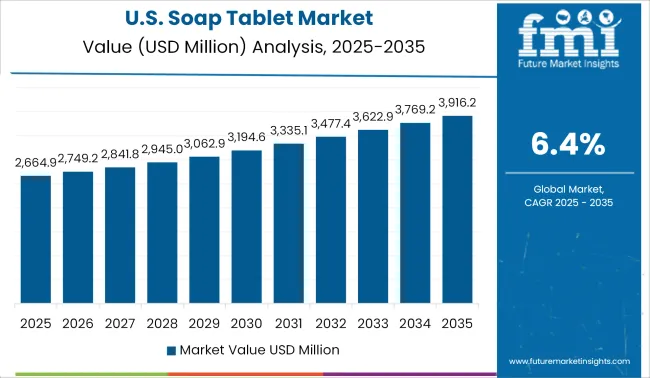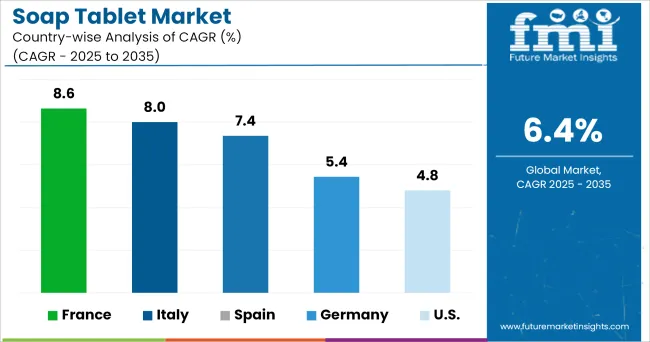The Soap Tablet Market is estimated to be valued at USD 8,565.1 million in 2025 and is projected to reach USD 15,927.5 million by 2035, registering a compound annual growth rate (CAGR) of 6.4% over the forecast period.

The soap tablet market is witnessing growing consumer acceptance, driven by the global shift toward sustainable personal care solutions and minimal packaging waste. Industry news and product innovations have emphasized the convenience and eco-friendliness of soap tablets, aligning with environmentally conscious lifestyle choices.
Consumers have increasingly sought personal hygiene products that combine skin compatibility with sustainable ingredients, enhancing the demand for naturally formulated soap tablets. Brands have expanded their product lines to cater to diverse skin types and preferences, while retail strategies have amplified product visibility in mainstream supermarket chains. Furthermore, gifting trends and travel-friendly packaging formats have enhanced the appeal of these products to modern consumers.
The market is expected to grow steadily as product innovations, sustainable packaging, and dermatological safety standards continue to influence purchase decisions. Segmental growth is led by Women in the end-use category, Supermarkets in distribution channels, and Dry Skin formulations, reflecting targeted consumer demand patterns and purchasing behavior.
The market is segmented by End-Use, Distribution Channel, and Skin Type and region. By End-Use, the market is divided into Women, Kid, Men, Pregnant Women, and Old People. In terms of Distribution Channel, the market is classified into Supermarkets, Department stores, Drugstores, Beauty salons, Specialty stores, Direct selling, and Online retailing.
Based on Skin Type, the market is segmented into Dry, Oily, Normal, Sensitive, and Other (combination). Regionally, the market is classified into North America, Latin America, Western Europe, Eastern Europe, Balkan & Baltic Countries, Russia & Belarus, Central Asia, East Asia, South Asia & Pacific, and the Middle East & Africa.

The Women segment is projected to contribute 42.3% of the soap tablet market revenue in 2025, establishing its leadership in the end-use category. Growth in this segment has been shaped by the increasing prioritization of skincare in women's daily routines and the desire for natural, chemical-free cleansing solutions.
Marketing efforts by personal care brands have focused on educating women about the environmental and skin health benefits of soap tablets, driving product adoption. Women consumers have shown a strong inclination toward products that offer moisturizing properties, pleasant fragrances, and minimalistic packaging, all of which soap tablets deliver.
Additionally, social media campaigns and influencer partnerships have played a crucial role in raising product awareness among female demographics. As brands continue to diversify their soap tablet offerings with women focused variants addressing skin hydration and sensitivity, the Women segment is expected to maintain its leading position in the market.

The Supermarkets segment is projected to hold 38.6% of the soap tablet market revenue in 2025, sustaining its role as the primary distribution channel. Growth in this segment has been driven by the widespread availability of soap tablets in organized retail outlets, where consumers often explore personal care aisles for trusted hygiene products.
Supermarkets have effectively promoted eco-friendly hygiene solutions by allocating shelf space and running in store campaigns, helping educate consumers on sustainable alternatives to liquid soaps. Retail partnerships with personal care brands have facilitated the inclusion of exclusive product variants and multipack offerings, further encouraging bulk purchases.
Consumer shopping patterns have indicated a preference for supermarkets due to their convenience, promotional pricing, and the ability to compare multiple brands in one location. As sustainable personal care becomes a mainstream consideration, the Supermarkets segment is expected to continue driving soap tablet market sales through strategic placement and consumer trust in retail availability.

The Dry Skin segment is projected to account for 35.8% of the soap tablet market revenue in 2025, positioning itself as the leading skin type category. Growth of this segment has been fueled by increasing consumer awareness regarding the importance of maintaining skin hydration during cleansing. Dermatological publications and product claims have highlighted the role of moisturizing ingredients in soap tablets designed for dry skin, addressing common concerns such as irritation and tightness post-wash.
Consumers experiencing dry skin have favored soap tablets enriched with plant oils, glycerin, and shea butter, which offer gentle cleansing without stripping natural oils. Seasonal demand spikes, particularly in colder climates where dry skin conditions are prevalent, have further boosted sales in this category.
Personal care brands have expanded their product lines to include dermatologist tested and hypoallergenic formulations, enhancing consumer trust. As skincare routines increasingly emphasize hydration and barrier repair, the Dry Skin segment is expected to maintain its strong performance in the soap tablet market.
Some of the factors driving the soap tablets market including the increasing number of enlightened and well-travelled consumers. Also, increasing customer knowledge of safety and sanitation is likely to boost the demand for soap tablets in the near future.
Soap tablets are more safe and efficient than the regular shop as they are available with precise size and are pre-equipped with additives and rinse aids, which enhanced the quality of cleaning and also, the chance of wastage is very less.
However, the coronavirus pandemic does not affect the market even, the demand for hygiene products including tablet soap is increasing in the market. Many players in the market take the advantage of the opportunity and expand their product portfolio.
For instance, Orial Imara (an India based soap tablet manufacturer and exporter) introduced Elaria, a tablet soap, which kill the germs and virus efficiently. Also, many people use such tablet soaps in place of sanitizers because these are only used by one person at a time so there is no chance of transformation of the virus and also, sanitizer leave the hand feeling itchy and dry. This raises the demand of soap tablets during the pandemic all around the globe.
People are becoming more conscious about the negative effects of synthetic chemicals used in the manufacturing process of soap, thus a growing number of customers are opting for organic and natural hygiene products, such as soap tablets. As a result, many players invest in the R&D sector and introducing natural soap that propelling the soap tablet market forward.
For instance, MOYENNE launched tablet soap which is light in weight, compact size and made up of natural high-quality biodegradable environmentally friendly materials, these are very suitable for school, camping, business travel, hiking, barbecue and other outdoor activities.
Furthermore, people purchase this tablet because of its compact size. It is very difficult for people to use soap while travelling and then again packed used soap. These types of tablet soap are the better option for the tourist. Moreover, this soap is a good choice for men, they can put this tablet in their wallets. All such factors fuel the sales of the soap tablet.

Environmental safety, sustainability, and green development are proven to be more appealing to citizens in the region. Youth take part in the demonstrations against firms that destroy the environment. Players are encouraged to focus not only on hygiene products but also on environmentally friendly products as a result of the trend of customers turning to more sustainable products.
Furthermore, the rise in customer preference for soap tablets is predominantly due to their hygiene considerations, energy-saving characteristics, and convenience in the region likely to increase the sales in the regional market.
The rise in the soap tablet industry in the region is also due to men's growing awareness of self-care, personal hygiene, healthy-looking, and skincare. Players are primarily involved in order to get momentum with millennial males. This product portfolio expansion by the company gains a competitive advantage in the regional market.

The inclination of customers towards a healthy lifestyle and the increasing demands for sustainable hygiene products is expected to grow in the regional market in the near future. Also the increasing trend of vegan products among millennials fueling the demand growth in Europe.
Furthermore, hotels and luxury resorts are increasing in European countries because of the increase in the number of tourists in the region. So, there is a good option for the hotel management to add soap tablets in their toiletry gift. Soap tablets are a new product in the market and it is a product of luxury. This increases the demand for soap tablets in the regional market.

Players invest a huge amount in the research and development sector to innovate advanced technology that will reduce the overall energy, time and water of the user. Some of the leading manufacturers and suppliers of soap tablets include
Companies of soap tablets are focusing on strengthening their presence and distribution channels in organized retailing to generate more sales revenue. Furthermore, Players are collaborating with local farmers to source natural ingredients directly from them, which help the company to increases the product’s attractiveness to the customers.
The report is a compilation of first-hand information, qualitative and quantitative assessment by industry analysts, inputs from industry experts and industry participants across the value chain. The report provides in-depth analysis of parent market trends, macro-economic indicators and governing factors along with market attractiveness as per segments. The report also maps the qualitative impact of various market factors on market segments and geographies.
The global soap tablet market is estimated to be valued at USD 8,565.1 million in 2025.
The market size for the soap tablet market is projected to reach USD 15,927.5 million by 2035.
The soap tablet market is expected to grow at a 6.4% CAGR between 2025 and 2035.
The key product types in soap tablet market are women, kid, men, pregnant women and old people.
In terms of distribution channel, supermarkets segment to command 38.6% share in the soap tablet market in 2025.






Our Research Products

The "Full Research Suite" delivers actionable market intel, deep dives on markets or technologies, so clients act faster, cut risk, and unlock growth.

The Leaderboard benchmarks and ranks top vendors, classifying them as Established Leaders, Leading Challengers, or Disruptors & Challengers.

Locates where complements amplify value and substitutes erode it, forecasting net impact by horizon

We deliver granular, decision-grade intel: market sizing, 5-year forecasts, pricing, adoption, usage, revenue, and operational KPIs—plus competitor tracking, regulation, and value chains—across 60 countries broadly.

Spot the shifts before they hit your P&L. We track inflection points, adoption curves, pricing moves, and ecosystem plays to show where demand is heading, why it is changing, and what to do next across high-growth markets and disruptive tech

Real-time reads of user behavior. We track shifting priorities, perceptions of today’s and next-gen services, and provider experience, then pace how fast tech moves from trial to adoption, blending buyer, consumer, and channel inputs with social signals (#WhySwitch, #UX).

Partner with our analyst team to build a custom report designed around your business priorities. From analysing market trends to assessing competitors or crafting bespoke datasets, we tailor insights to your needs.
Supplier Intelligence
Discovery & Profiling
Capacity & Footprint
Performance & Risk
Compliance & Governance
Commercial Readiness
Who Supplies Whom
Scorecards & Shortlists
Playbooks & Docs
Category Intelligence
Definition & Scope
Demand & Use Cases
Cost Drivers
Market Structure
Supply Chain Map
Trade & Policy
Operating Norms
Deliverables
Buyer Intelligence
Account Basics
Spend & Scope
Procurement Model
Vendor Requirements
Terms & Policies
Entry Strategy
Pain Points & Triggers
Outputs
Pricing Analysis
Benchmarks
Trends
Should-Cost
Indexation
Landed Cost
Commercial Terms
Deliverables
Brand Analysis
Positioning & Value Prop
Share & Presence
Customer Evidence
Go-to-Market
Digital & Reputation
Compliance & Trust
KPIs & Gaps
Outputs
Full Research Suite comprises of:
Market outlook & trends analysis
Interviews & case studies
Strategic recommendations
Vendor profiles & capabilities analysis
5-year forecasts
8 regions and 60+ country-level data splits
Market segment data splits
12 months of continuous data updates
DELIVERED AS:
PDF EXCEL ONLINE
Soap Salts Market Size and Share Forecast Outlook 2025 to 2035
Soap Noodles Market Size and Share Forecast Outlook 2025 to 2035
Soap Dispenser Market Trends - Demand & Forecast 2025 to 2035
Soap Boxes Market Analysis – Growth & Demand 2025 to 2035
The Bar Soap Market is segmented by material type, application, quality, and sub-region from 2025 to 2035.
Liquid Soap Market Trends & Forecast 2025-2035
Organic Soap Market Analysis – Growth & Industry Trends 2024-2034
Electric Soap Dispenser Market Size and Share Forecast Outlook 2025 to 2035
Electronic Soap Dispenser Market Size and Share Forecast Outlook 2025 to 2035
Liquid Hand Soap Market Size and Share Forecast Outlook 2025 to 2035
Cold Pressed Soap Market Analysis - Trends, Growth & Forecast 2025 to 2035
Powdered Hand Soap Market
Latin America Hand Soap Market Size and Share Forecast Outlook 2025 to 2035
Car Wash Detergents Market Growth & Trends 2024-2034
Tablet Hardness Testers Market Size and Share Forecast Outlook 2025 to 2035
Tabletop CNC Milling Machines Market Analysis - Size, Share, and Forecast Outlook 2025 to 2035
Tablet Packing Machine Market Size and Share Forecast Outlook 2025 to 2035
Tablets for Oral Suspension Market Analysis Size and Share Forecast Outlook 2025 to 2035
Tablet Press Machines Market Size and Share Forecast Outlook 2025 to 2035
Tablet Based E-Detailing Market Size and Share Forecast Outlook 2025 to 2035

Thank you!
You will receive an email from our Business Development Manager. Please be sure to check your SPAM/JUNK folder too.
Chat With
MaRIA